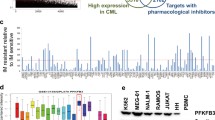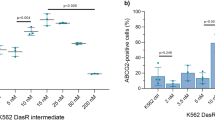Abstract
Tyrosine kinase inhibitors (TKIs) are highly effective in treating chronic myelogenous leukemia (CML). However, primary and acquired drug resistance to TKIs have been reported. In this study, we used RNA sequencing followed by RQ-PCR to show that the proto-oncogene EVI1 targets the drug-metabolizing gene PTGS1 in CML. The PTGS1 promoter element had an EVI1 binding site, and CHIP assay confirmed its presence. Data from a publicly available CML microarray dataset and an independent set of CML samples showed a significant positive correlation between EVI1 and PTGS1 expression in CML. Downregulation of EVI1 in K562 cells and subsequent treatment with TKIs resulted in a lower IC50 in the control cells. Furthermore, combined inhibition of BCR-ABL with imatinib and PTGS1 with FR122047 (PTGS1 inhibitor) synergistically reduced the viability of imatinib-resistant K562 cells. We conclude that elevated EVI1 expression contributes to TKIs resistance and that combined inhibition of PTGS1 and BCR-ABL may represent a novel therapeutic approach.




Similar content being viewed by others
Data availability
All the data are available on request to the corresponding author.
References
Arunasree KM, Roy KR, Anilkumar K, Aparna A, Reddy GV, Reddanna P. Imatinib-resistant K562 cells are more sensitive to celecoxib, a selective COX-2 inhibitor: role of COX-2 and MDR-1. Leuk Res. 2008;32:855–64.
Chandrasekhar J, Mehran R. The role of genetics in acute coronary syndrome. Cardiovascular diseases: genetic susceptibility, environmental factors and their interaction. London: JAcademic Press; 2016. p. 25–55.
Daghistani M, Marin D, Khorashad JS, Wang L, Philippa CM, Paliompeis C, et al. EVI-1 oncogene expression predicts survival in chronic-phase CML patients resistant to imatinib treated with second-generation tyrosine kinase inhibitors. Blood. 2010;116:6014–7.
Diamond JM, Melo JV. Mechanisms of resistance to BCR-ABL kinase inhibitors. Leuk Lymphoma. 2011;52:12–22.
Dreos R, Ambrosini G, Groux R, Perier RC, Bucher P. The eukaryotic promoter database in its 30th year: focus on non-vertebrate organisms. Nucleic Acids Res. 2017;45:D51–5.
Dreos R, Ambrosini G, Périer RC, Bucher P. The Eukaryotic promoter database: expansion of EPDNew and new promoter analysis tools. Nucleic Acids Res. 2015;43:D92–6.
Flamant S, Kortulewski T, Dugray A, Bonnet ML, Guillier M, Guilhot F, et al. Osteopontin is upregulated by BCR-ABL. Biochem Biophys Res Commun. 2005;333:1378–84.
Flis S, Bratek E, Chojnacki T, Piskorek M, Skorski T. Simultaneous inhibition of BCR-ABL1 Tyrosine Kinase and PAK1/2 Serine/Threonine Kinase Exerts Synergistic Effect against Chronic Myeloid Leukemia Cells. Cancers (Basel). 2019;11:1544.
Fu L, Fu H, Tian L, Xu K, Hu K, Wang J. High expression of RUNX1 is associated with poorer outcomes in cytogenetically normal acute myeloid leukemia. Oncotarget. 2016;7:15828–39.
Fuchs O. EVI1 and its role in myelodysplastic syndrome, myeloid leukemia and other malignant diseases. Cas Lek Cesk. 2006;145:619–24.
Ghasemian Sorbeni F, Montazersaheb S, Ansarin A, Esfahani A, Rezamand A, Sakhinia E. Molecular analysis of more than 140 gene fusion variants and aberrant activation of EVI1 and TLX1 in hematological malignancies. Ann Hematol. 2017;96:1605–23.
Glass C, Wilson M, Gonzalez R, Zhang Y, Perkins AS. The role of EVI1 in myeloid malignancies. Blood Cells Mol Dis. 2014;53:67–76.
Jabbour E, Kantarjian H. Chronic myeloid leukemia: 2018 update on diagnosis, therapy and monitoring. Am J Hematol. 2018;93:442–59.
Kataoka K, Sato T, Yoshimi A, Goyama S, Tsuruta T, Kobayashi H. Evi1 is essential for hematopoietic stem cell self-renewal, and its expression marks hematopoietic cells with long-term multilineage repopulating activity. J Exp Med. 2011;208:2403–16.
Kuila N, Nayak KB, Halder A, Agatheeswaran S, Biswas G, Biswas S, et al. Ecotropic viral integration site I regulates alpha1, 6-fucosyl transferase expression and blocks erythropoiesis in chronic myeloid leukemia. Leuk Lymphoma. 2017;58:1941–7.
Lee KC, Ouwehand I, Giannini AL, Thomas NS, Dibb NJ, Bijilmakers MJ. Lck is a key target of imatinib and dasatinib in T-cell activation. Leukemia. 2010;24:896–900.
Liang B, Wang J. EVI1 in leukemia and solid tumors. Cancers (Basel). 2020;12:2667.
Liu Y, Chen L, Ko TC, Fields AP, Thompson EA. Evi1 is a survival factor which conveys resistance to both TGFβ- and taxol-mediated cell death via PI3K/AKT. Oncogene. 2006;25:3565–75.
Loscocco F, Visani G, Galimberti S, Curti A, Isidori A. BCR-ABL independent mechanisms of resistance in chronic myeloid leukemia. Front Oncol. 2019;9:939.
Lu Y, Liang Y, Zheng X, Deng X, Huang W, Zhang G. EVI1 promotes epithelial-to-mesenchymal transition, cancer stem cell features and chemo-/radioresistance in nasopharyngeal carcinoma. J Exp Clin Cancer Res. 2019;38:82.
Melo JV, Barnes DJ. Chronic myeloid leukaemia as a model of disease evolution in human cancer. Nat Rev Cancer. 2007;7:441–53.
Mosmann T. Rapid colorimetric assay for cellular growth and survival: application to proliferation and cytotoxicity assays. J Immunol Methods. 1983;65:55–63.
Nishikawa S, Arai S, Masamoto Y, Kagoya Y, Toya T, Watanabe-Okochi N, Kurokawa M. Thrombopoietin/MPL signaling confers growth and survival capacity to CD41-positive cells in a mouse model of Evi1 leukemia. Blood. 2014;124:3587–96.
Niu Y, Yang X, Chen Y, ** X, Li L, Guo Y, Li X, **e Y, Zhang Y, Wang H. EVI1 induces autophagy to promote drug resistance via regulation of ATG7 expression in leukemia cells. Carcinogenesis. 2020;41:961–71.
Ochi T, Goto T. Anti-inflammatory effect of FR140423, a novel selective cyclo-oxygenase-2 inhibitor, in rat adjuvant arthritis without gastrointestinal side effects. J Pharm Pharmacol. 2000;52:553–60.
Ochi T, Goto T. Differential effect of FR122047, a selective cyclo-oxygenase-1 inhibitor, in rat chronic models of arthritis. Br J Pharmacol. 2002;135:782–8.
Paquette RL, Nicoll J, Chalukya M, Elashoff D, Shah NP, Sawyers C. Frequent EVI1 translocations in myeloid blast crisis CML that evolves through tyrosine kinase inhibitors. Cancer Genet. 2011;204:392–7.
Patel SB, Nemkov T, Stefanoni D, Benavides GA, Bassal MA, Crown BL, et al. Metabolic alterations mediated by STAT3 promotes drug persistence in CML. Leukemia. 2021;35:3371–82.
Pradeepa, Suresh V, Senapati S, Chakraborty S. AKT inhibition sensitizes EVI1 expressing colon cancer cells to irinotecan therapy by regulating the Akt/mTOR axis. Cell Oncol (Dordr). 2022;45:659–75.
Puissant A, Dufies M, Fenouille N, Sahra IB, Jacquel A, Robert G, et al. Imatinib triggers mesenchymal-like conversion of CML cells associated with increased aggressiveness. J Mol Cell Biol. 2012;4:207–20.
Radich JP. The Biology of CML blast crisis. Hematol Am Soc Hematol Educ Program. 2007;2007:384–91.
Radich JP, Dai H, Mao M, Oehler V, Schelter J, Druker B, et al. Gene expression changes associated with progression and response in chronic myeloid leukemia. Proc Natl Acad Sci USA. 2006;103:2794–9.
Rommer A, Steinmetz B, Herbst F, Hackl H, Heffeter P, Heilos D, et al. EVI1 inhibits apoptosis induced by Antileukemic drugs via upregulation of CDKN1A/p21/WAF in human myeloid cells. PLoS One. 2013;8: e56308.
Roobrouck VD, Wolfs E, Delforge M, Broekaert D, Chakraborty S, Sels K, et al. Multipotent adult progenitor cells improve the hematopoietic function in myelodysplasia. Cytotherapy. 2017;19:744–55.
Sato T, Goyama S, Kataoka K, Nasu R, Tsuruta-Kishino T, Kagoya Y, et al. Evi1 defines leukemia-initiating capacity and tyrosine kinase inhibitor resistance in chronic myeloid leukemia. Oncogene. 2014;33:5028–38.
Shimada K, Tomita A, Minami Y, Akihiro A, Hind CK, Kiyoi H, et al. CML cells expressing the TEL/MDS1/EVI1 fusion are resistant to imatinib-induced apoptosis through inhibition of BAD, but are resensitized with ABT-737. Exp Hematol. 2012;40:724–37.
Sinnakannu JR, Lee KL, Cheng S, Li J, Yu M, Tan SP, et al. SRSF1 mediates cytokine-induced impaired imatinib sensitivity in chronic myeloid leukemia. Leukemia. 2020;34:1787–98.
Tip** AJ, Deininger MW, Goldman JM, Melo JV. Comparative gene expression profile of chronic myeloid leukemia cells innately resistant to imatinib mesylate. Exp Hematol. 2003;31:1073–80.
Villuendas R, Steegmann JL, Pollán M, Tracey L, Granda A, Fernandez-Ruiz E, et al. Identification of genes involved in imatinib resistance in CML: a gene-expression profiling approach. Leukemia. 2006;20:1047–54.
Wang J, Hughes TP, Kok CH, Saunders VA, Frede A, Groot-Obbink K, Osborn M, Somogyi AA, D’Andrea RJ, White DL. Contrasting effects of diclofenac and ibuprofen on active imatinib uptake into leukaemic cells. Br J Cancer. 2012;106:1772–8.
Yoshimi A, Kurokawa M. Evi1 forms a bridge between the epigenetic machinery and signaling pathways. Oncotarget. 2011;2:575–86.
Yuan X, Wang X, Bi K, Jiang G. The role of EVI-1 in normal hematopoiesis and myeloid malignancies (review). Int J Oncol. 2015;47:2028–36.
Zhang WW, Cortes JE, Yao H, Zhang L, Reddy NG, Jabbour E, et al. Predictors of primary imatinib resistance in chronic myelogenous leukemia are distinct from those in secondary imatinib resistance. J Clin Oncol. 2009;27:3642–9.
Acknowledgements
The DST-SERB NPDF fellowship was awarded to Dr. Kittappa Vinothkumar funded the work (PDF/2017/000139). The work was also partly funded by two other SERB projects, EMR/2014/000318 and CRG/2019/003113, awarded to Dr. Soumen Chakraborty. Sayantan Chanda is supported by University Grants Commission and is registered for the Ph.D. program at the Regional Centre for Biotechnology, Faridabad. The Institute of Life Sciences supported Dr. Vivek Singh.
Author information
Authors and Affiliations
Contributions
KVK, SC and SC designed the experiments. KVK and SC performed the experiments. VS performed all the sequencing analyses. SM, SB, and GB provided the clinical inputs. KVK, SC and SC wrote the manuscript. SC reviewed and corrected the manuscript and arranged the funds. All authors approved the final version of the manuscript.
Corresponding author
Ethics declarations
Conflict of interest
The authors report that there is no conflict of interest to declare.
Ethical approval
The institutional human ethical committee approved the study (65/HEC/17), and the peripheral blood samples were collected from the patients after obtaining written informed consent. All procedures performed in studies involving human participants were by the ethical standards of the institutional research committee and with the 1964 Helsinki Declaration and its later amendments or comparable ethical standards.
Additional information
Publisher's Note
Springer Nature remains neutral with regard to jurisdictional claims in published maps and institutional affiliations.
Supplementary Information
Below is the link to the electronic supplementary material.


About this article
Cite this article
Vinothkumar, K., Chanda, S., Singh, V.K. et al. EVI1 upregulates PTGS1 (COX1) and decreases the action of tyrosine kinase inhibitors (TKIs) in chronic myeloid leukemia cells. Int J Hematol 117, 110–120 (2023). https://doi.org/10.1007/s12185-022-03465-y
Received:
Revised:
Accepted:
Published:
Issue Date:
DOI: https://doi.org/10.1007/s12185-022-03465-y




